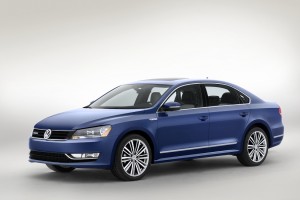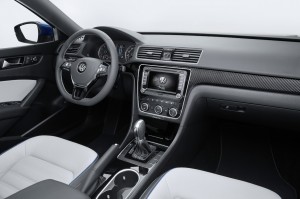There are a number of folks – including some California regulators – who’d be happy to see the internal combustion engine go extinct. But as makers of hybrids and other battery-cars have learned to their chagrin, the time-tested ICE is proving a moving target that’s shown a lot more life than many expected.
A case in point is the Volkswagen Passat BlueMotion Concept making its world debut next week at the North American International Auto Show. With a highway fuel economy rating estimated at 42 mpg, the German sedan is nudging into compact and even subcompact territory.
How get near-hybrid efficiency out of a conventional gasoline engine? VW engineers pulled several tricks out of their sleeves. For one thing, the BlueMotion Concept adopts increasingly familiar Stop/Start technology which briefly shuts the engine off, rather than idling. There’s also a transmission decoupling system that lets the Passat prototype freewheel when coasting, reducing normal frictional losses. But there’s an even more novel approach alternately known as cylinder deactivation and variable displacement.
Now, wait a second, you might be ready to declare. There are plenty of vehicles that can shut off cylinders when loads are light to reduce fuel consumption. Indeed, but they’re normally six, eight or even twelve-cylinder designs. The VW Passat BlueMotion Concept is powered by a mere 1.4-liter turbocharged direct-injection inline-four. When it’s cruising or coasting it can operate as a two-cylinder engine.
(Click Here to check out VW’s most powerful hot hatch ever, the gen-4 Golf R.)
When demands are more severe, the engine manages a reasonable 150 horsepower and 184 pound-feet of torque. That compares quite favorably with the current Passat 1.8-liter turbo I-4 which makes just 140 hp and yields a mere 35 mpg on the highway.
Of course, numbers don’t tell the whole story. We’ll press Volkswagen’s product PR team for a drive, if possible, to see how the BlueMotion Concept actually performs under various conditions. We’re wondering how it feels during a hard launch, and whether there’s much noise or vibration when it shifts into twin-cylinder mode.
The approach, nonetheless, is intriguing and could offer some advantages over the crop of new three-cylinder engines being brought to market by manufacturers as diverse as Ford, Mini and BMW.
(3-Cylinders? Mini set to launch new, high-mileage engine on next-gen Hardtop. Click Herefor details.)
Beyond the key powertrain technologies, the show car gets a few modest styling tweaks to distinguish it from the stock Passat, including the distinctive Reef Blue Metallic exterior paint, aero-design wheels, and two-tone blue striped seats.
Might this package make it into production? We could readily imagine Europeans going for it, but the U.S. is a bit less of a slam dunk. Then again, this sort of mileage out of a car like the Passat could prove quite appealing to some motorists, especially if Volkswagen can find a way to package it all together without a diesel or hybrid-like price penalty.



Volkswagen has already developed the cylinder deactivation on the I-4 and it works pretty well. The start-stop tech has been available for several years and it works very well IME. As has been known for quite some time, clean Diesels are far better for the task than EV’s and many expensive, complicated hybrids but the Obama administration and the EPA don’t want what’s best for the populace, they want to push impractical EV’s.
I wonder how those EVs have worked out in the Arctic freeze the U.S. has had recently?
The VW 1.4-litre TSI ACT (cylinder deactivation system) was voted at the Engine Expo International as the “Best New Engine” of 2013.
Quote from the Internet (test drive of the small VW POLO 1.4 TSI ACT):
“Temporary shutoff of the second and third cylinders – in conjunction with an economical style of driving – reduces fuel consumption by over 0.5 liters per 100 kilometers.
Even with two cylinders the excellently balanced 1.4 TSI runs just as quietly and with low vibration as with four active combustion chambers.”
The consumption reduction comes from the fact that the two active cylinders of VW operate at substantially heavier load when the two others are deactivated.
At light loads the efficiency of the spark ignition engine drops a lot.
The bad thing with VW’s solution is that the deactivated cylinders still have pistons and piston rings reciprocating inside them consuming energy as friction.
When the VW ACT engine operates at partial loads, it pays its vibration-free quality / smoothness / quietness with the friction (mechanical energy loss) of moving a pair of “useless” pistons / sets of piston rings.
If the two deactivated pistons could be removed, the reduction of the fuel consumption would double (?), as well as the vibrations and the noise.
Unless I am wrong, the two middle cylinders of VW ACT engine are the only ones that are deactivated. What is the long-term effect on the engine after, say, 100.000 miles? Is it clever to operate at heavy load the two “worn” cylinders and leave the actually “unused” pair of cylinders idle? Does it reduce the TBO?
By the way, the “cylinder deactivation” in Diesels is not so good because the friction of the idle cylinders is bigger and because the thermal efficiency of the Diesels at partial loads is not bad.
What the VW Passat TSI ACT proves is that a single combustion per crankshaft rotation is acceptable / adequate for small and medium size cars (a four-stroke with two active cylinders has one combustion per each rotation of the crankshaft).
The same is proved by the four-stroke two-cylinder TwinAir engine of FIAT / Chrysler used in several small / medium size cars like the New Alfa Romeo Mito TwinAir. In this case (true twin cylinder engine) the absence of another pair of “driven / inactive / power consuming” cylinders reduces the friction and increases the mileage (as well as the inertia vibrations and the noise).
A well balanced internal combustion engine having one combustion (i.e. one power pulse) per crankshaft rotation seems as the future for “green” small-medium size cars.
With the cylinder-liner rid of intake and exhaust ports, the single-cylinder two-stroke PatPortLess engine at http://www.pattakon.com/pattakonPatPortLess.htm combines among others:
true “four-stroke” lubrication,
true “four-stroke” specific lube consumption,
true “four-stroke” scuffing resistance,
true “four-stroke” emissions,
and one combustion per crankshaft rotation, i.e. as much as the VW Passat 1.4 TSI ACT (at partial loads) and as much as the Alfa Romeo Mito TwinAir.
As for the smoothness / “vibration-free” quality of the single-cylinder PatPortLess, it is comparable to that of the four-in-line of VW Passat 1.4 TSI ACT and it is substantially better than that of the two-cylinder TwinAir of FIAT / Alfa Romeo (last GIF animation in the abovementioned web page).
So, would you consider buying a small – medium size car having a single cylinder engine?
Thanks
Manousos Pattakos